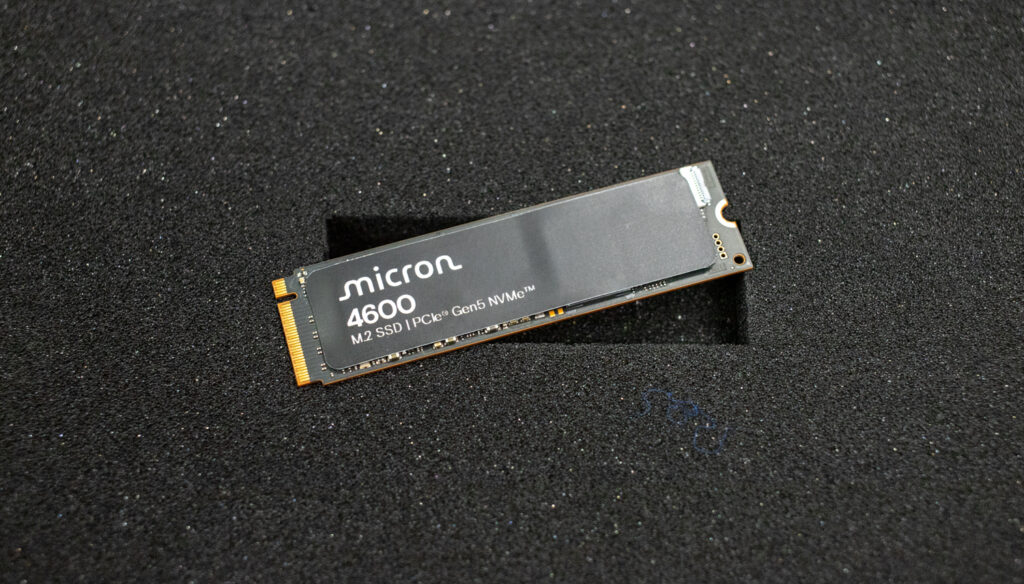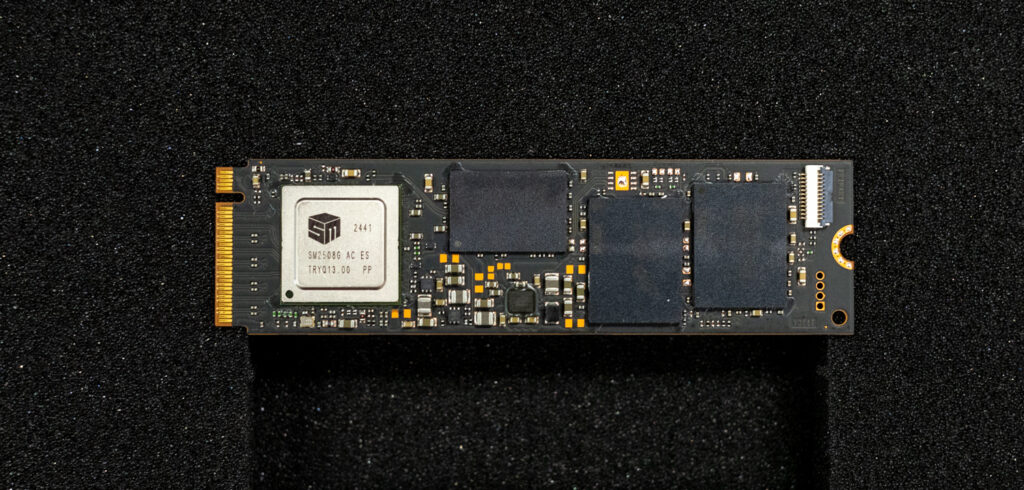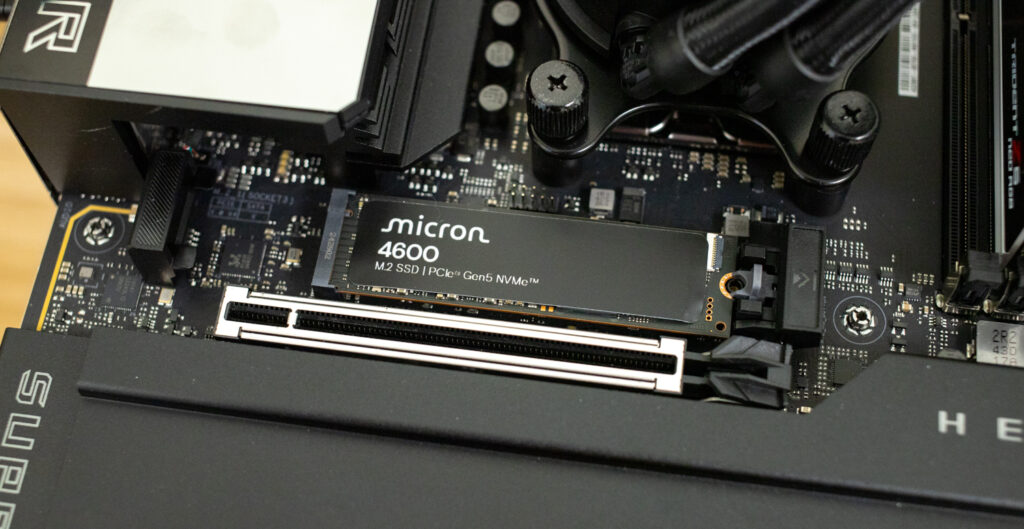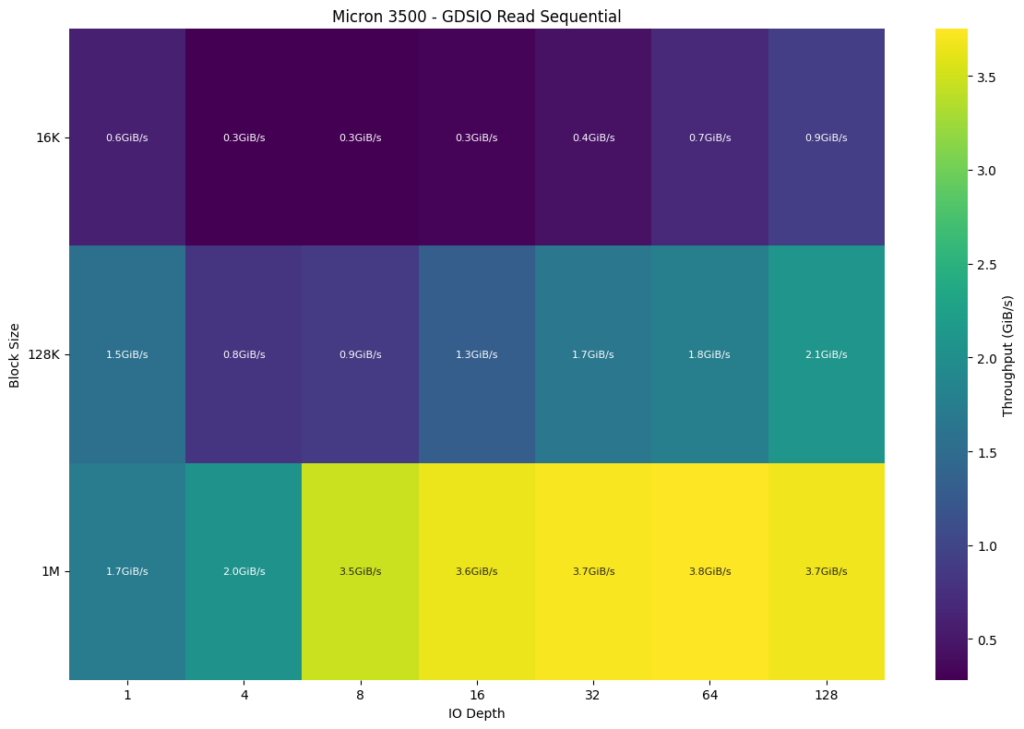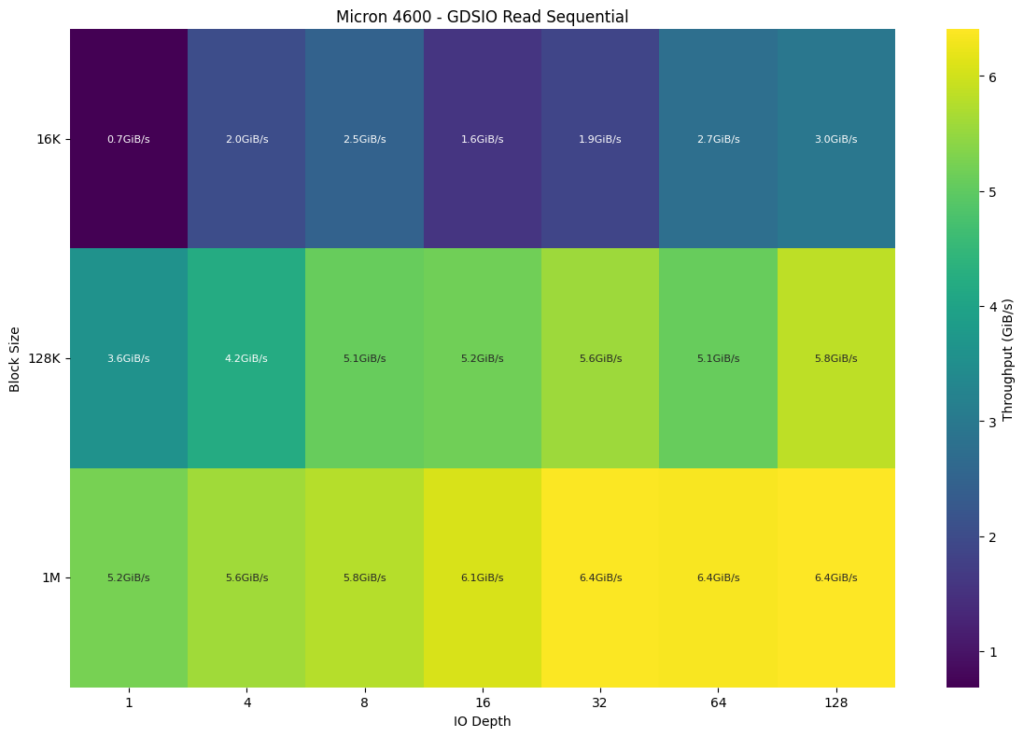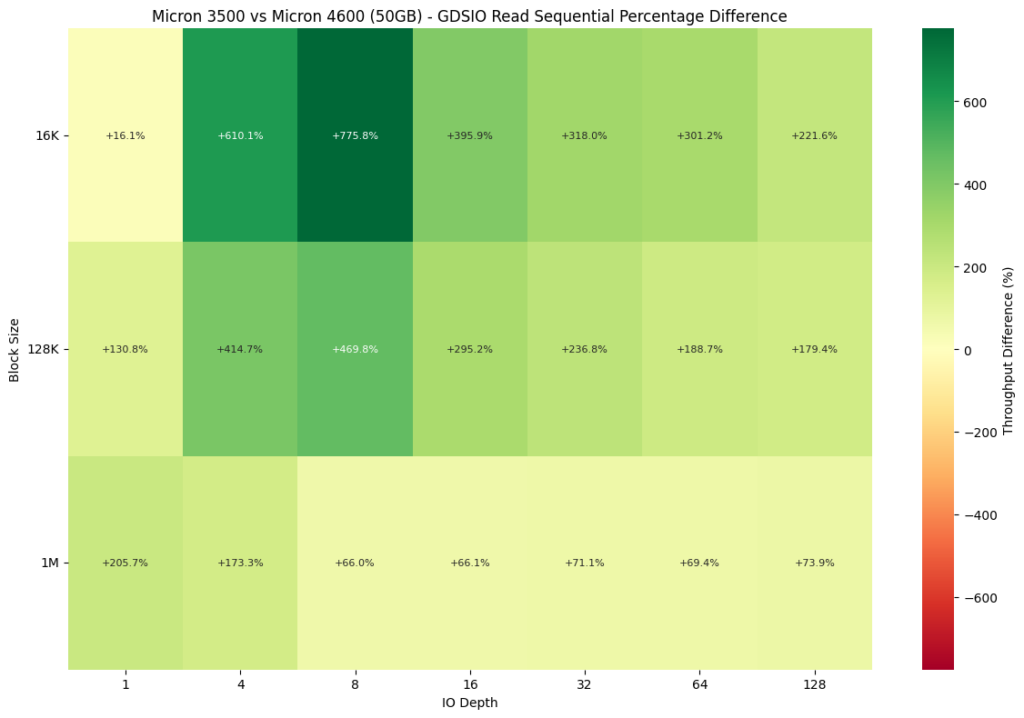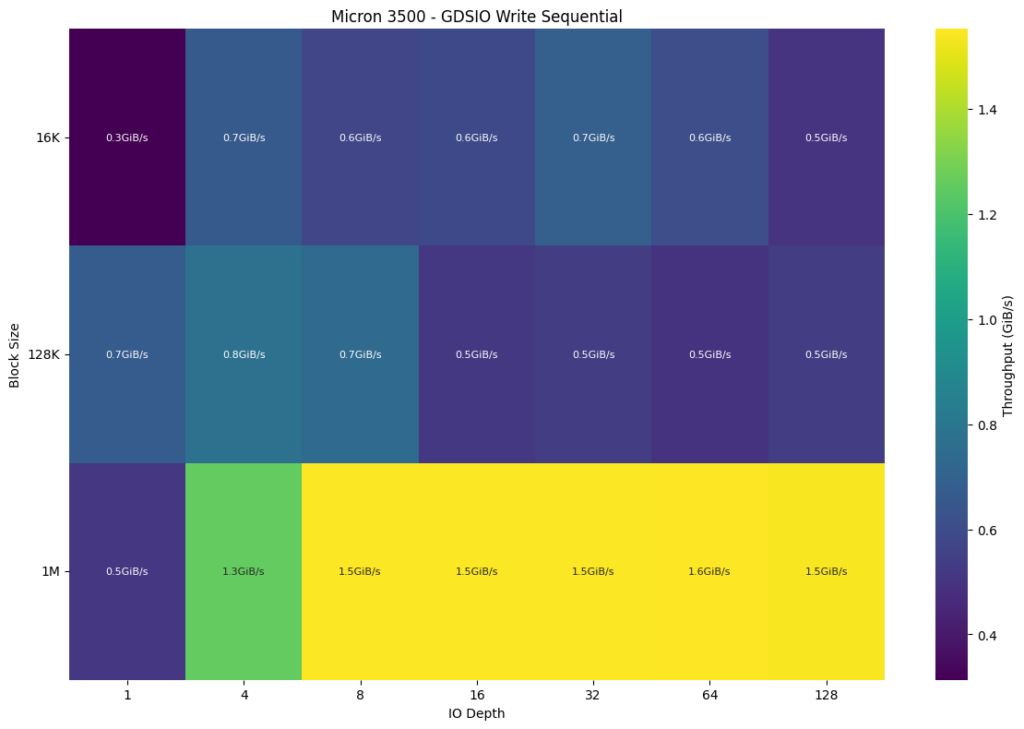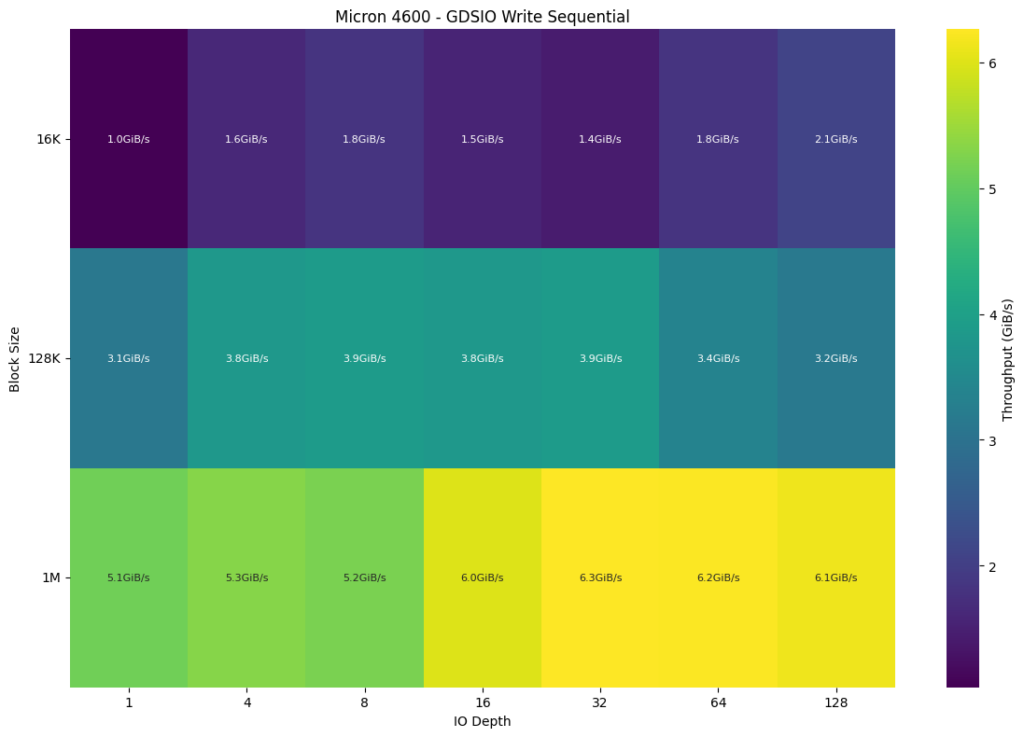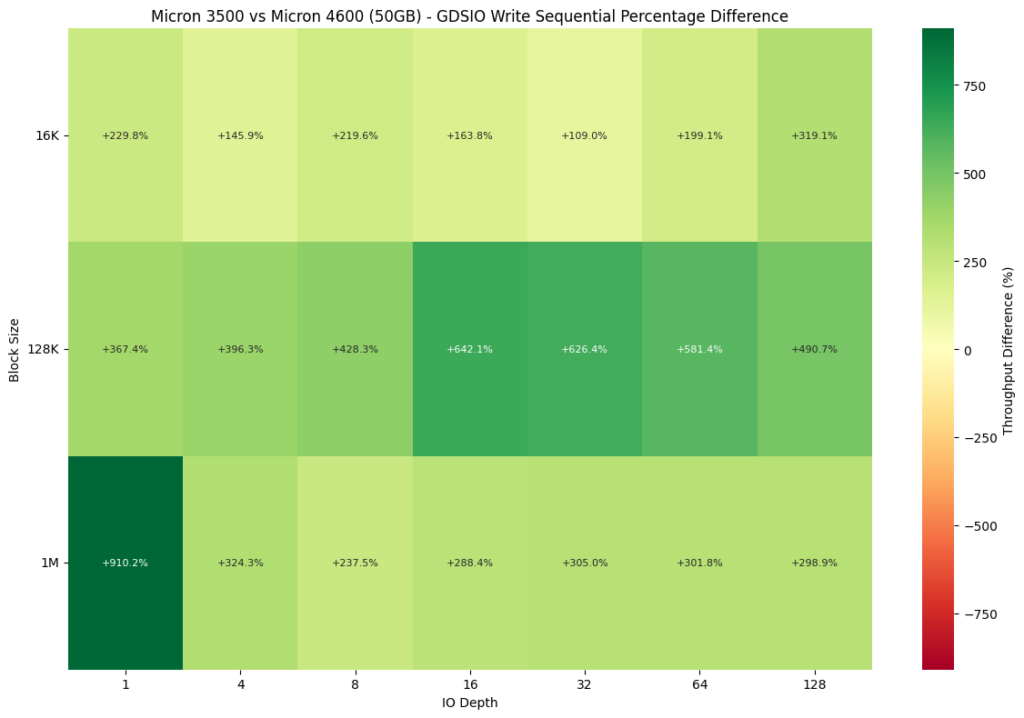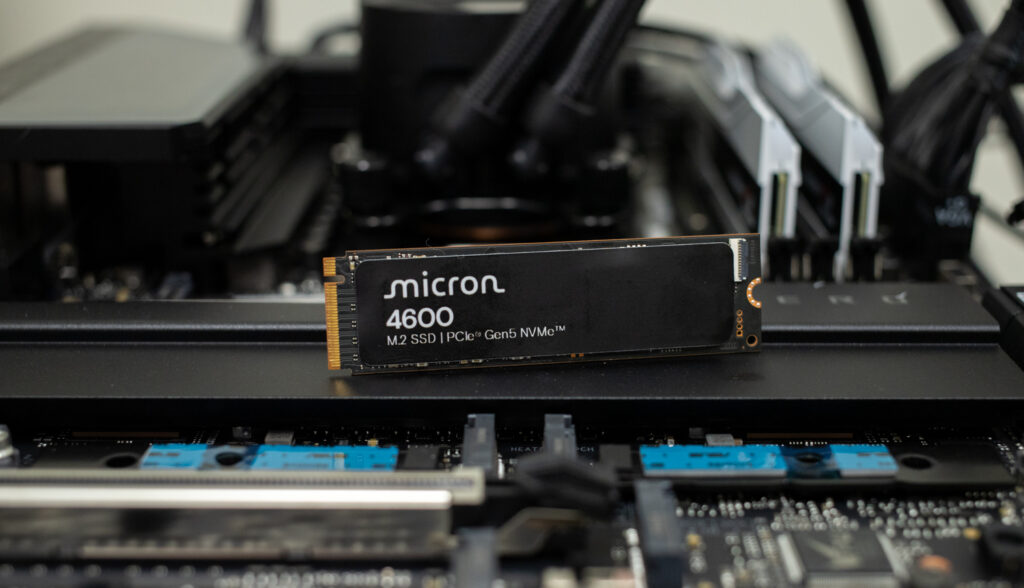Micron 4600 Gen5 SSD delivers high-speed storage for AI, workstations, and gaming, with up to 14.5GB/s reads and faster AI model loading.
Micron is bringing PCIe Gen5 storage to its client SSD lineup with the Micron 4600 NVMe SSD, a high-performance drive aimed at creative professionals, AI workloads, and gamers—essentially anyone who needs fast, responsive storage in a workstation or gaming rig. The 4600 doubles sequential read speeds over its Gen4 predecessor, hitting up to 14.5GB/s reads and 12GB/s writes, but the real-world impact extends beyond synthetic benchmarks. Micron has focused on improving “felt performance,” such as application responsiveness, large dataset handling, and AI model loading. It is an ideal choice for system builders looking to deliver high-performance configurations.
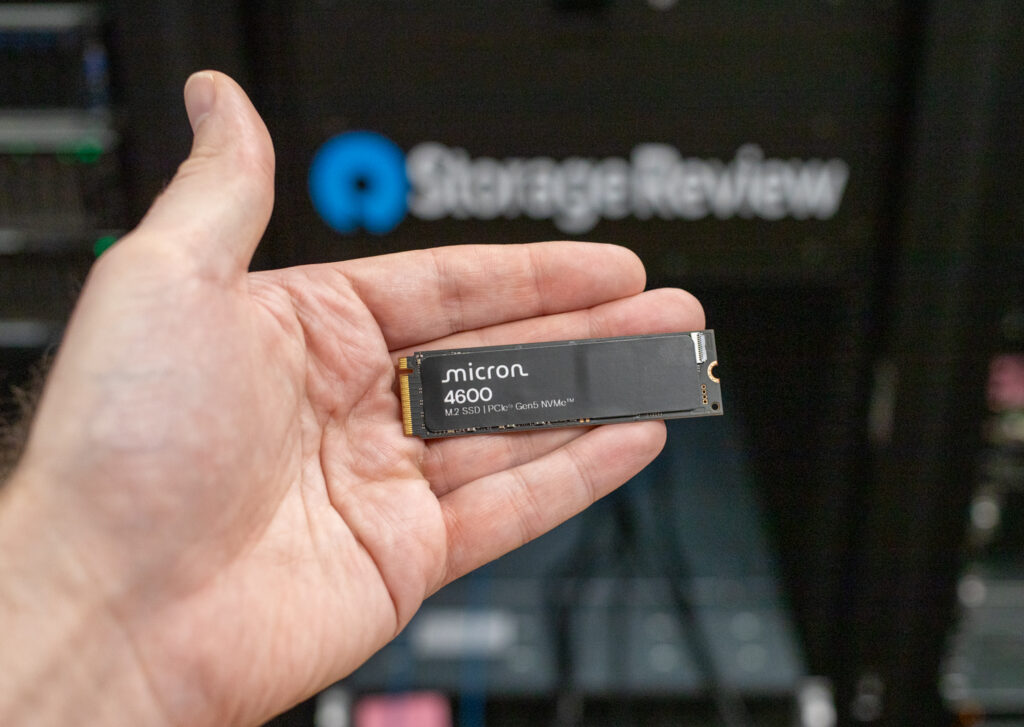
High-speed burst performance is only part of the Micron 4600’s story. Sustained performance and responsiveness under demanding workloads are just as critical, particularly for professionals working with data science, AI model training, and machine learning inference. AI applications stand to benefit from faster LLM model loading, with Micron reporting sub-one-second load times for Llama-2 models—a 61% improvement over Gen4 SSDs. This level of storage performance ensures that researchers and engineers can work with massive datasets and complex models without bottlenecks, keeping GPUs and CPUs fully utilized instead of waiting on storage.
According to Micron’s testing, the drive also delivers a meaningful boost in everyday computing tasks, as evidenced by its 11% higher PCMark 10 benchmark scores than competing Gen5 SSDs. PCMark 10 evaluates real-world workflows, including Windows boot times, application launches (such as Adobe Photoshop and Illustrator), and general productivity tasks. These gains translate to a more responsive user experience in a business environment or a high-end creative workflow.
The Micron 4600’s support for Microsoft’s DirectStorage API is particularly significant for gamers. DirectStorage enables GPUs to communicate directly with high-speed NVMe SSDs, bypassing the CPU and drastically reducing load times while improving asset streaming. With over 30 games already supporting DirectStorage and more titles on the way, the impact of next-gen storage in gaming is becoming increasingly apparent. The Micron 4600 ensures players can experience near-instantaneous level transitions, richer textures, and more expansive worlds, making it a compelling choice for gaming PCs.
Beyond raw performance, the Micron 4600 brings a range of optimizations tailored for demanding workloads. It features Micron’s G9 TLC NAND with dynamic SLC caching, ensuring sustained performance under heavy loads and on-board DRAM for low-latency access. Security is another primary focus, with SPDM support, TCG Opal, Pyrite, and DICE compliance, making it ideal for professionals handling sensitive data. Additionally, Micron has optimized power efficiency, claiming over 107% better random read/write energy efficiency than its Gen4 predecessor—a critical advantage for high-performance mobile workstations where power efficiency matters as much as speed.
This review will examine the Micron 4600 SSD’s real-world performance across professional applications, AI workloads, and gaming, benchmarking it against the Micron 3500 to quantify the generational leap. LLM model loading is particularly interesting; we’ll test that workflow alongside synthetic benchmarks, application-based workloads, and system-wide performance scenarios. Let’s see if the 4600 sets a new standard for PCIe Gen5 client SSDs.
Micron 4600 Specifications
The 4600 offers a PCIe Gen5 x4 / NVMe 2.0c interface in a 2280 M.2 form factor. Capacities include 512GB, 1TB, 2TB, and 4TB; our review unit is the 2TB capacity point.
The 4600’s NAND package layout uses just one side of the PCB for the 2TB capacity. The single-sided PCB design was also used with the previous-generation 3500 SSD. Micron uses its own G9 TLC NAND on the board, paired with a Silicon Motion SM2508 Gen5 controller and its in-house firmware.
The full Micron 4600 specs are listed below.
| Specification | Micron 4600 NVMe SSD |
|---|---|
| Interface | PCIe Gen5 x4, NVMe 2.0c |
| Form Factor | M.2 2280 |
| NAND Type | Micron G9 TLC NAND |
| Capacities | 512GB, 1TB, 2TB, 4TB |
| Sequential Read | Up to 14,500 MB/s |
| Sequential Write | Up to 12,000 MB/s |
| Random Read (4K, QD128) | Up to 2,100K IOPS |
| Random Write (4K, QD128) | Up to 2,100K IOPS |
| Endurance (TBW) | 512GB – 300 TBW, 1TB – 600 TBW, 2TB – 1,200 TBW, 4TB – 1,600 TBW |
| Security Features | SPDM, TCG Opal 2.02, TCG Pyrite 2.01, DICE, DOE |
| MTTF | 2 Million Hours |
| Power Consumption | Active Read: <8.25W, Active Idle: <150mW, Sleep: <3.5mW |
| Thermal Management | Host-controlled thermal management (HCTM), Thermal SMART data via SMBus |
| Warranty | 3 Years |
Performance
To measure the performance of Micron’s newest 4600 client SSD, we leveraged our AMD Ryzen 7 consumer test platform. This board supports multiple PCIe Gen5 SSDs, which we leveraged when testing the drive as a secondary storage device to the boot SSD. Our testing approach for this client SSD used a mixture of Windows and Linux-based applications. For the Windows-based tests, including PCMark, 3DMark, and BlackMagic, we used Windows 11 Pro 24H2, while the AI and FIO Linux-based workloads operated on Ubuntu 24.10 Desktop.
Test Platform
- AMD Ryzen 7 9800X3D
- Asus ROG Crosshair X870E Hero
- G.SKILL Trident Z5 Royal Series DDR5-6000 (2x16GB)
- NVIDIA GeForce RTX 4090
- Windows 11 Pro
- Ubuntu 24.10 Desktop
Peak Synthetic Performance
The FIO test is a flexible and powerful benchmarking tool used to measure the performance of storage devices, including SSDs and HDDs. It evaluates metrics such as bandwidth, IOPS (Input/Output Operations Per Second), and latency under different workloads, like sequential and random read/write operations. This test helps to assess the peak performance of storage systems, making it useful for comparing different devices or configurations. We measured the peak burst performance for this test, limiting the workload to a 10GB footprint on both SSDs.
| FIO Test (higher MB/s/IOPS Is better) | Micron Client 3500 Gen 4 | Micron Client 4600 Gen 5 |
|---|---|---|
| Sequential 128K Read (2T/64Q) | 6,480 MB/s (2.6ms avg latency) | 14,400 MB/s (1.16ms avg latency) |
| Sequential 128K Write (2T/64Q) | 6,921 MB/s (2.4ms avg latency) | 14,000 MB/s (1.19ms avg latency) |
| Random 4K Read (16T/32Q) | 1.185M IOPS (0.431 ms avg latency) | 2.04M IOPS (0.251 ms avg latency) |
| Random 4K Write (16T/32Q) | 796K IOPS (0.642 ms avg latency) | 2.36M IOPS (0.216 ms avg latency) |
In the FIO test measuring peak sequential and random performance, the Micron Client Gen 5 4600 outperformed the Gen 4 3500 across all metrics. It nearly doubles all metrics, hitting 14,400 MB/s read and 14,000 MB/s write. Random 4K operations achieve up to 2.04 million IOPS read and 2.36 million IOPS write, with much higher IOPS and lower latency, making it a clear choice for demanding workloads.
SPECworkstation 4.0
SPECworkstation 4.0 is a comprehensive workstation benchmark assessing 23 workloads and over 80 subtests across seven industry verticals and four hardware subsystems. This major update introduces support for AI and machine learning workloads, including data science and ONNX runtime-based inference tests, reflecting the increasing importance of these technologies in professional environments. While the primary benchmark includes several system-wide tests, we focus on the storage-specific WPCstorage test in this review. It leverages storage traces captured from typical industry applications to allow users to measure the performance deltas between systems and components.
| SPECworkstation 4.0 (higher is better) | Micron 3500 Gen4 | Micron 4600 Gen5 |
|---|---|---|
| WPCstorage | 1.50 | 1.87 |
Looking at storage-specific WPCstorage, the Gen 5 drive scores 1.87, a solid improvement over the Gen 4’s 1.50, showing the benefits of PCIe Gen 5 in real-world storage applications.
Blackmagic Disk Speed Test
The Blackmagic Disk Speed Test benchmarks a drive’s read and write speeds, estimating its performance, especially for video editing tasks. It helps users ensure their storage is fast enough for high-resolution content, like 4K or 8K video.
| Blackmagic (higher is better) | Micron 3500 | Micron 4600 |
|---|---|---|
| Read MB/s | 5617.9MB/s | 9320.2MB/s |
| Write MB/s | 5879.5MB/s | 10825.4MB/s |
The Micron Client Gen 5 4600 delivers a massive leap in performance over the Gen 4 3500, boosting read speeds by 66% (9,320.2 MB/s vs. 5,617.9 MB/s) and nearly doubling write speeds (10,825.4 MB/s vs. 5,879.5 MB/s). This makes it a game-changer for professionals handling 4K, 8K, or RAW video, ensuring faster rendering, exports, and smoother playback.
GPU Direct Storage
One of the tests we conducted on this server was the Magnum IO GPU Direct Storage (GDS) test. GDS is a feature developed by NVIDIA that allows GPUs to bypass the CPU when accessing data stored on NVMe drives or other high-speed storage devices. Instead of routing data through the CPU and system memory, GDS enables direct communication between the GPU and the storage device, significantly reducing latency and improving data throughput.
How GPU Direct Storage Works
Traditionally, when a GPU processes data stored on an NVMe drive, the data must first travel through the CPU and system memory before reaching the GPU. This process introduces bottlenecks, as the CPU becomes a middleman, adding latency and consuming valuable system resources. GPU Direct Storage eliminates this inefficiency by enabling the GPU to access data directly from the storage device via the PCIe bus. This direct path reduces the overhead associated with data movement, allowing faster and more efficient data transfers.
AI workloads, especially those involving deep learning, are highly data-intensive. Training large neural networks typically requires processing terabytes of data, and any delay in data transfer can lead to underutilized GPUs and longer training times. GPU Direct Storage addresses this challenge by ensuring that data is delivered to the GPU as quickly as possible, minimizing idle time and maximizing computational efficiency.
In addition, GDS is particularly beneficial for workloads that involve streaming large datasets, such as video processing, natural language processing, or real-time inference. By reducing the reliance on the CPU, GDS accelerates data movement and frees up CPU resources for other tasks, further enhancing overall system performance.
Testing Configuration Matrix
We systematically tested every combination of the following parameters:
- Block Sizes: 1M, 128K, 16K
- IODepth: 128, 64, 32, 16, 8, 4, 1
For this review, we focused on sequential read and write throughput with a 50G footprint on each SSD. We performed each GDSIO workload at its given block size and thread count across multiple job and batch sizes. The reported figures are the averages of each job and batch count combination.
In our first chart, we look at the previous generation of Micron 3500. In our sequential read test, we measured a top speed of 0.9GiB/s in 16K, 2.1GiB/s in 128K, and 3.7GiB/s in 1M sequential read transfer sizes.
Next, we look at the same workloads on the new Micron 4600 Gen5 SSD, which saw a substantial uplift in performance across the workloads measured. We measured 3GiB/s in 16K, 5.8GiB/s in 128K, and 6.4GiB/s in 1M sequential read transfers.
Looking at a comparison heatmap across the blocksize and queue depths measured in GDSIO from the Micron 3500 and 4600 SSDs, we see the most significant increases in the 128K block size range.
Switching to write transfers across the same workloads, we measured peak 16K transfers of 0.7GiB/s for 16K, 0.8GiB/s for 128K, and 1.6GiB/s for 1M in our sequential write test. These values were measured at lower queue depth levels than peak saturation.
The updated Gen5 Micron 4600 fared much better in our write GDSIO workload, with a peak 16K transfer speed of 2.1GiB/s, a peak 128K transfer of 3.9GiB/s, and 6.3GiB/s for the 1M transfer size. Like the 3500 write results, many of the highest throughputs came lower than peak IO depths.
Comparing the two drives head to head in a write performance heatmap, we see the Micron 4600 offered a substantial boost again compared to the previous generation model. These improvements were visible across the spectrum of IO depths and block sizes.
PCMark10 Storage
PCMark 10 Storage Benchmarks evaluate real-world storage performance using application-based traces. They test system and data drives, measuring bandwidth, access times, and consistency under load. These benchmarks provide practical insights beyond synthetic tests, helping users compare modern storage solutions effectively.
| PCMark10 (higher is better) | Micron Client 3500 Gen 4 Score | Micron Client 4600 Gen 5 Score |
|---|---|---|
| Storage Data Score | 7,169 | 8,282 |
The Micron Client Gen 5 4600 outperforms the Gen 4 3500 in PCMark 10 Storage, scoring 8,282 compared to 7,169, representing a 15.5% increase in real-world performance.
3DMark Direct Storage
The 3DMark DirectStorage Feature Test evaluates how Microsoft’s DirectStorage optimizes game asset loading on PCIe SSDs. By reducing CPU overhead and improving data transfer speeds, DirectStorage enhances loading times, especially when paired with GDeflate compression and Windows 11’s BypassIO. This test isolates storage performance to highlight the potential bandwidth improvements when DirectStorage is enabled.
| 3DMark Direct Storage | Micron 3500 Gen4 | Micron 4600 Gen5 |
|---|---|---|
| Storage to VRAM (GDeflate Compression) | 14.96 GB/s | 26.27 GB/s |
| Storage to VRAM (DirectStorage on, Uncompressed) | 6.36 GB/s | 10.81 GB/s |
| Storage to VRAM (DirectStorage off, Uncompressed) | 5.43 GB/s | 6.54 GB/s |
| Storage to RAM (DirectStorage on, Uncompressed) | 6.64 GB/s | 12.35 GB/s |
| Storage to RAM (DirectStorage off, Uncompressed) | 6.01 GB/s | 8.25 GB/s |
| GDeflate Decompression Bandwidth | 64.03 GB/s | 67.63 GB/s |
The Micron Client Gen 5 4600 significantly outperforms the Gen 4 3500 in DirectStorage scenarios, especially in storage to VRAM with GDeflate compression, delivering 26.27 GB/s versus 14.96 GB/s, a 75% increase. Other significant gains include storage to RAM at 12.35 GB/s versus 6.64 GB/s, up 86%, and storage to VRAM with DirectStorage on at 10.81 GB/s versus 6.36 GB/s, up 70%. These improvements translate to faster game asset loading, reduced CPU overhead, and better performance in DirectStorage-enabled titles, making Gen 5 the better choice for gaming and high-speed data streaming.
Conclusion
The Micron 4600 NVMe SSD delivers on its promise of next-generation PCIe Gen5 performance, offering significant gains over its predecessor, the Micron 3500, and proving itself a versatile choice for AI development, gaming, and professional applications. With up to 14.5GB/s read and 12GB/s write speeds (we tested faster writes), it doubles the sequential performance of Gen4 drives. More importantly, it improves real-world usability with faster application load times, lower latency, and significant efficiency gains.
The Micron 4600 NVMe SSD performance is substantially improved over the previous-generation 3500. The newer Gen5 interface significantly improved overall sequential bandwidth, moving from 6.5GB/s read to 14.4GB/s and write speeds from 6.9GB/s to 14GB/s in our tests. Random I/O speeds also had massive uplifts, moving from 1.2M IOPS read to 2M IOPS and 800K IOPS write to 2.4M IOPS.
Many applications were able to take advantage of those benefits, including workstation applications and emerging AI workflows. GPUDirect storage performance measured with NVIDIA’s GDSIO tool had massive gains across our 16K, 128K, and 1M sequential read and write workloads. With AI development workloads pushing down into the local workstation space, the importance of fast storage can’t be overlooked.
The Micron 4600 stands out for professionals who need high-performance local storage and gamers looking to minimize load times – giving OEMs a reliable, future-proof storage solution to include in their builds. As AI and high-performance computing objectives evolve, fast, efficient storage will play an increasingly critical role—and the Micron 4600 proves it’s ready for that future.
This report is sponsored by Micron. All views and opinions expressed in this report are based on our unbiased view of the product(s) under consideration.
Engage with StorageReview
Newsletter | YouTube | Podcast iTunes/Spotify | Instagram | Twitter | TikTok | RSS Feed

